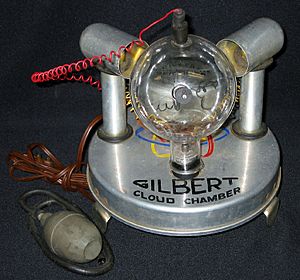Gilbert U-238 Atomic Energy Laboratory facts for kids
The Gilbert U-238 Atomic Energy Lab was a unique toy set. It was created by Alfred Carlton Gilbert. He was an American athlete, magician, and inventor. He also invented the popular Erector Set. His company, the A. C. Gilbert Company, released this lab in 1950. The toy was designed to let children explore nuclear and chemical reactions. It even used real radioactive materials.
What Was in the Lab?
The lab kit included several interesting tools. A cloud chamber allowed you to see tiny alpha particles. These particles moved incredibly fast, about 12,000 miles per second! A spinthariscope showed flashes of light. These flashes happened when radioactive materials broke down. An electroscope could measure how radioactive different substances were.
Gilbert's advertisements claimed that none of the materials were dangerous. The instructions told users to keep their lab area clean. They warned not to open the jars with ore samples. This was because the ore could crumble easily. If the ore spread, it would increase the background radiation. This would make the experiments less accurate. The company also stated that Oak-Ridge Laboratories had checked the materials. They certified everything as "completely safe."
Kit Contents and Price
The set originally sold for $49.50 in 1950. This was quite a lot of money back then!
The kit contained many items:
- A battery-powered Geiger counter. This device detects radiation.
- An Electroscope.
- A Spinthariscope.
- A Wilson cloud chamber. It came with a short-lived alpha source.
- Four glass jars with natural uranium-bearing ore samples. These included autunite, torbernite, uraninite, and carnotite. They came from the "Colorado plateau region."
- Low-level radiation sources:
- "Nuclear spheres" to build a model of an alpha particle.
- The Gilbert Atomic Energy Manual. This was a 60-page instruction book.
- Learn How Dagwood Split the Atom. This was a comic book about radioactivity.
- Prospecting for Uranium. This book was published by the United States Atomic Energy Commission and the United States Geological Survey.
- Three C batteries.
- A 1951 Gilbert Toys catalog.
The product catalog described the cloud chamber as amazing. It said you could "actually SEE the paths of electrons and alpha particles." It claimed this was the closest anyone could get to "watching the Atom!"
One fun activity suggested in the kit was "playing hide and seek with the gamma ray source." Players would use the Geiger counter to find a hidden radioactive sample in a room.
Why Wasn't It Popular?
Unlike other chemistry sets from the A.C. Gilbert Company, the Atomic Energy Lab was not very popular. It was quickly removed from store shelves. Fewer than 5,000 kits were sold in total. The product was only available in 1950 and 1951.
Gilbert thought the lab was not successful because it was better for people with some science knowledge. It was not as simple for the younger kids his company usually aimed for. Interestingly, Columbia University bought five of these sets for their physics lab.
Images for kids




